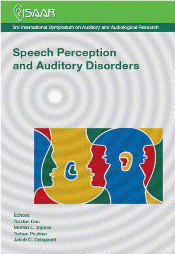Distortion Product Otoacoustic Emissions (DPOAE) after exposure to noise and music of equal energy
Abstract
Exposure to intense noise and music can result in Temporary Threshold Shifts (TTS). Previous investigations suggest that music and noise may induce TTS differently and that the magnitude of TTS after noise exposure is larger compared to music exposure. Listening to music may induce unknown effects in the medial olivocochlear bundle which may suppress the size of the TTS. Ten normal hearing listeners were exposed for 10 minutes to 100 dB SPL familiar and unfamiliar music or noise on separate days. During the exposure of music or noise the test subjects focused entirely on the auditory stimulus. In a parallel experiment, the subjects had non-auditory attention on a puzzle task (the Tower of Hanoi). The order of the experiments was randomized. Pre- and post-exposure Distortion Product Otoacoustic Emissions (DPOAE) were measured at 2, 3 and 4 kHz. DPOAE response was suppressed on both ears immediately after noise exposure and on the left or the right ear after familiar and unfamiliar music exposure, respectively. Auditory attention compared to non-auditory attention resulted in higher DPOAE suppression on the left ear. In conclusion, music and noise with equal energy suppressed DPOAE responses on both ears but with noticeable differences between ears.
References
Axelsson, A. and Lindgren, F. (1978). "Temporary threshold shift after exposure to pop music" Scand. Audiol., 7, 127-135.
Axelsson, A. and Lindgren, F. (1981). "Pop music and hearing" Ear Hear., 2,64-69.
Brashears, S. M., Morlet, T. G., Berlin, C. I., and Hood, L. J. (2003). "Olivocochlear efferent suppression in classical musicians" J. Am. Acad. Audiol., 14, 314-324.
Clark, W. W. (1991). "Recent studies of temporary threshold shift (TTS) and permanent threshold shift (PTS) in animals" J. Acoust. Soc. Am., 90, 155-163.
Darrow, K. N., Maison, S. F., and Liberman, M. C. (2006). "Cochlear efferent feedback balances interaural sensitivity" Nat. Neurosci., 9, 1474-1476.
Lindgren, F. and Axelsson, A. (1983). "Temporary threshold shift after exposure to noise and music of equal energy" Ear Hear., 4, 197-201.
Maison, S., Micheyl, C., and Collet, L. (2001). "Influence of focused auditory attention on cochlear activity in humans" Psychophysiology, 38, 35-40.
Micheyl, C., Carbonnel, O., and Collet, L. (1995). "Medial olivocochlear system and loudness adaptation: differences between musicians and non-musicians" Brain Cogn., 29, 127-136.
Schmidt, J. H., Pedersen, E. R., Juhl, P. M., Christensen-Dalsgaard, J., Andersen, T. D., Poulsen, T., and Baelum, J. (2011). "Sound Exposure of Symphony Orchestra Musicians" Ann.Occup.Hyg.,[Doi:10.1093/annhyg/mer055,pp 1-13].
Strasser, H., Irle, H., and Legler, R. (2003). "Temporary hearing threshold shifts and restitution after energy-equivalent exposures to industrial noise and classical music" Noise. Health, 5, 75-84.
Swanson, S. J., Dengerink, H. A., Kondrick, P., and Miller, C. L. (1987). "The influence of subjective factors on temporary threshold shifts after exposure to music and noise of equal energy" Ear Hear., 8, 288-291.
Wagner, W., Heppelmann, G., Kuehn, M., Tisch, M., Vonthein, R., and Zenner, H. P. (2005). "Olivocochlear activity and temporary threshold shift-susceptibility in humans" Laryngoscope, 115, 2021-2028.
Additional Files
Published
How to Cite
Issue
Section
License
Authors who publish with this journal agree to the following terms:
a. Authors retain copyright* and grant the journal right of first publication with the work simultaneously licensed under a Creative Commons Attribution License that allows others to share the work with an acknowledgement of the work's authorship and initial publication in this journal.
b. Authors are able to enter into separate, additional contractual arrangements for the non-exclusive distribution of the journal's published version of the work (e.g., post it to an institutional repository or publish it in a book), with an acknowledgement of its initial publication in this journal.
c. Authors are permitted and encouraged to post their work online (e.g., in institutional repositories or on their website) prior to and during the submission process, as it can lead to productive exchanges, as well as earlier and greater citation of published work (See The Effect of Open Access).
*From the 2017 issue onward. The Danavox Jubilee Foundation owns the copyright of all articles published in the 1969-2015 issues. However, authors are still allowed to share the work with an acknowledgement of the work's authorship and initial publication in this journal.


